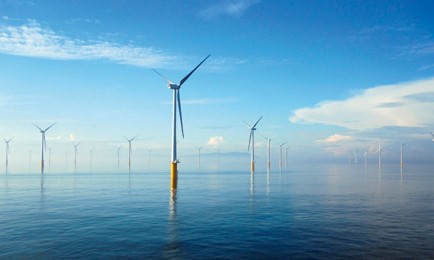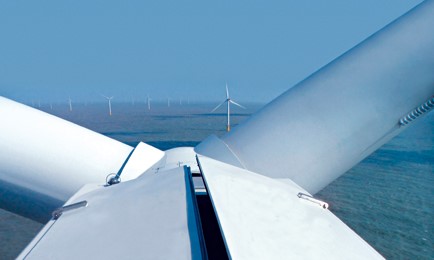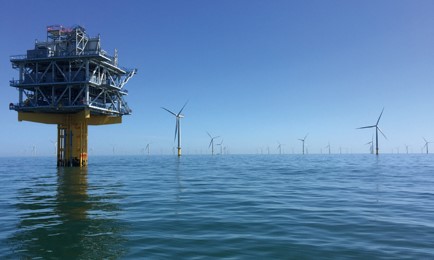Running the world's biggest wind farm is a mammouth task
29 June 2015
This article, by Joe Hibbert, published in The Institution of Mechanical Engineers magazine, shows how improvements in wind turbine technology are delivering better efficiencies in an electricity generation.
On a glorious day in mid-May, an azure sky and calm waters provide a mixed blessing for the engineers in charge of London Array, the biggest offshore windfarm in the world. As our vessel slips out of the port of Ramsgate on its 20km journey to the turbines, general manager Mike O’Hare predicts a problem.
“Beautiful days like this are great for maintenance,” he says. “We can get a lot of technicians out here and they can get a lot of work done. But with weather as calm as this, we won’t be generating much electricity. Indeed, there’s a chance that not a blade will be turning.”

Forty-five minutes later, as we approach London Array, O’Hare is proved to be right. Each of the 175 Siemens 3.6MW turbines stands perfectly still. “It’s very rare that the turbines don’t turn at all,” he says. “Probably 10 days a year. But, as I say, it does give us the chance to push on with our planned and unplanned maintenance activities.”
London Array became a fully functioning windfarm supplying the national grid in October 2012. Positioned off the Essex and Kent coast, in the outer Thames Estuary, it occupies an area of 100km2. The windfarm is rated at 630MW, although performance data shows it is achieving a 40% capacity factor, averaged over a year.
Wind flow maximised
The turbines are placed 650m to 1,200m apart, exporting electricity via 33kV undersea cables to two three-storey, 1,250 tonne offshore substations. The output is transformed to 150kV, and is exported to an onshore substation at Cleve Hill, near Graveney in Kent. Here the power is boosted further and fed into the national grid at 400kV.
The positioning of the turbines is interesting in itself. Each structure is placed in a very specific location, producing a carefully considered pattern, to maximise wind flow. Up close, you can see that the 60m blades are curved outwards to quite some degree. This stops them from striking the tower during peak wind conditions, when violent loading forces push them towards the main structure.
London Array employs 90 people at its Ramsgate headquarters, with 70 technicians responsible for performing operations and maintenance. The technicians are taken to work by a fleet of five crew transfer vessels, and they work 12-hour shifts – four hours of preparation and mobilisation, and eight hours on the turbines.
O’Hare is responsible for overseeing this activity. “London Array is a fully operational windfarm,” he says. “My role is to keep the turbines running and to get the best performance and the most electricity out of them. Last year, the breakdown of maintenance activity came out at 50% planned and 50% unplanned. And these two distinct types of work present us with very different challenges.”
Each turbine is designed to run for more than 20 years, 24 hours a day, seven days a week. Of course, weather conditions dictate otherwise. No wind means no movement, and when the wind speed reaches 50mph the turbines are shut down to protect them from damage.

O’Hare says that since London Array became fully operational, there has been relatively little requirement for major turbine overhaul. “It’s honestly been really positive. We have had some really good availability,” he says. “In fact, we have had just three major component repairs. One was a 43-tonne gearbox exchange that had to be craned into the nacelle. Then a few weeks ago we needed a vessel on site to change a transformer, and we are still doing some root-cause analysis on what happened there.
“And finally, there was an L17 main bearing exchange. Our vibration monitoring showed there was something not quite right in that case and, while it wasn’t critical, it could have become so. In the end we took the decision to replace the bearing, and the exchange took a small number of days and it is now back up and running.”
Preventative maintenance is also at the forefront of O’Hare’s mind. A turbine condition monitoring system sees each of the structures installed with vibration, temperature and oil-level sensors, with performance data fed back to a control room in real time, triggering alarms when it falls outside set parameters.
The most common unscheduled maintenance problems revolve around issues such as yaw system errors, hydraulic oil leaks, cooling system malfunction and general gearbox defects.
“The technicians are out on the turbines every day, weather permitting, dealing with these sorts of problems,” says O’Hare. “They are tightening-up bolts to stop vibration. They are topping-up oil and grease, and changing oil filters. There’s a diverse mix of repairs that the turbines need.”
Undersea Lasers
Condition monitoring isn’t restricted to the turbines. The undersea export cables are also assessed in real time for performance.
“Distributed temperature sensing is key to this,” says O’Hare. “We send lasers down optical fibres within our cables, getting tiny reflections back as we move along the route. Based on the frequency and the magnitude of those reflections, it is possible to work out the temperature at every point along the cable. We are looking for cold spots developing, which probably means the cable is no longer beneath the surface, as the water is taking away the heat. We want the cables to be buried to stop them snagging on fishing nets or being damaged by anchors.”
Contingency planning has also been developed with the supply chain. “If we do have a failure with any major component, we hit the ground running,” he says. “We know who to contact to get more parts in the quickest time possible. We are fully prepared for what can happen.”
Lean servicing is also being increasingly adopted at London Array. The technicians work 12-hour shifts and O’Hare says it is crucial that they get as much spanner time as possible. “We are doing very well to improve that. And as technicians get used to the site and get used to the equipment, their effectiveness in using their time is also increasing. We want to get that extra hour on the turbines.”

Apart from maintenance, it has also been O’Hare’s team’s responsibility to help improve the performance of the turbines by retrofitting aerodynamically tuned add-on components. Blade modifications have come in the form of Siemens DinoTails, serrated flaps that are mounted at the airflow breakaway edge close to the blade tip, which accounts for most of the energy produced by the blade. By decreasing turbulence on the trailing edge, DinoTails can be used to enhance lifting performance while still keeping local acoustic emissions to a minimum.
DinoShells, meanwhile, are fixed control surfaces attached from the blade shoulder towards the root. These have helped to increase lift, especially on the root section of the blade closest to the hub. Vortex generators, finally, are designed to improve the flow of air over turbine blades in the so-called boundary layer, the region of flow very close to the surface.
Output boosted
O’Hare says these modifications can increase annual energy production by 1.5% at an annual average wind speed of 7.5m/s. “They have helped us capture more wind at lower wind speeds. That has helped us to get the overall output up over the course of the year,” he says.
Navigational safety is also a consideration. Some of the turbines at London Array are fitted with lights and foghorns to warn aircraft and ships of the windfarm’s presence. Lightning protection systems have also been fitted on all blades. “There are a lot of individual components on a wind turbine,” says O’Hare.
Maintenance work demands close liaison with local suppliers that provide many of the components and services that are required. At the initial construction stage, only Siemens in Manchester and cable-maker JDR in Hartlepool played much of a role in the supply chain. But now it’s a different story.
O’Hare says: “The operational phase makes it a lot easier for local companies to get involved. It’s more suited to the sort of scale of company that is located in and around the region. We have been trying to tap into the local supply chain. We hold regular ‘meet the buyer’ events and there’s a lot more we are trying to do to grow that. We’d like a lot more UK-supplied content.”
The maintenance efforts combine to make London Array a true success story, with its operational performance exceeding most predications.
The output for 2014 was more than 2.2TWh. “I don’t think there’s an offshore windfarm anywhere in the world that is doing that,” says O’Hare.
Timeline: Commissioning the windfarm
December 2003
London Array is awarded an agreement for lease by the Crown Estate in the government’s Round 2 offshore wind development programme.
June 2006
Planning consent is given for the offshore works.
July 2009
Work begins on the onshore substation at Cleve Hill.
March 2011
The first of 177 offshore foundation monopiles (175 turbines and two substations) is installed.
January 2012
Turbine installations begin
October 2012
Power production begins
December 2012
The final turbine is installed
April 2013
Windfarm fully operational
Summer 2013
Handover to the operations and maintenance team is complete
Chris Woodhams, Operations Manager at Argenta, commented "an interesting and in-depth article about the largest offshore wind farm in the world, based off the Essex and Kent coast. The condition monitoring technique for the export cables is a really good example of modern engineering. With a power output of 2.2TWh in 2014, it will be fascinating to see if wind power becomes viable green energy source for the future. Our links with companies in the renewable energy sector are increasing so we are always interested in examples of what is happening in different areas of a fast developing sector"
Accreditation: Institution of Mechanical Engineers, Lee Hibbert, 4th June 2015. The original article was sourced here.
Back to Blog listings